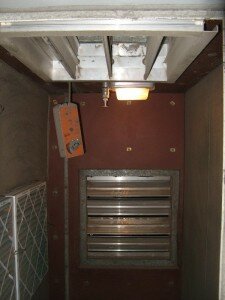How to cool for free
Wednesday, July 8th, 2009Free cooling takes advantage of cold outside air to cool a warm building. Strictly speaking “free cooling” isn’t free as energy is used by fans to move air from inside to outside. Free cooling is beneficial for any building where there are significant heat loads inside.
Server rooms and data centres can benefit enormously from free cooling, and in fact is the main reason why Google’s major server rooms are located in cold climates. It’s also beneficial for large office buildings where internal heat loads from people, lighting and office equipment mean that the core of the building is warm, even though it may cold outside. Buildings with glazing facing the sun can often benefit due to the heat load from solar heat gain. Its been our experience that in temperate climate’s such as Melbourne even small buildings can benefit from free cooling.
To cool for “free” your building’s air handing system needs to have an “economy cycle” installed. An economy cycle has a large fresh air intake, and also a large spill or relief air outlet. Rather than recirculating most of the air in the building as is normally done, with an economy cycle the air is not recirculated, it simply comes in, provides cooling, then is vented out again.
If an economy cycle is not operating, not only is fan energy used to recirculate the air, but energy is used to provide cold refrigerant or chilled water to coils that cool the air that is being recirculated.
Your building’s air handling system may already have an economy cycle fitted. Its worth while finding out if it does, and if so, if its operating properly. Common problems that limit the effective use of an economy cycle are:
- Very tight temperature settings with a narrow deadband (see an early blog post on what is a comfortable office tempature for more on dead-bands)
- Faulty actuators. These may not be fully opening or closing the supply air, return air and spill air dampers.
- Faulty dampers. Dampers may be broken, rusted in position or seized.
- Controls that can’t enable an economy cycle, even though all the hardware is in place.
- Out of calibration sensors, that don’t call for an economy cycle when needed.
- The supply air vent is located in a warm plant room, so that an economy cycle won’t work even though its cold outside.
On the other hand your system may not be set up for an economy cycle. This is the case with many packaged air conditioners. In this case to get free cooling an economy cycle may have to be retrofitted. This involves increasing the sizes of the supply and spill (relief) air dampers and ducts as needed, the fitting of motorised dampers, and upgrading of the controls.
Small server rooms cooled by split system air conditioners can often be easily set up for free cooling by setting up the necessary duct work. The more equipment in the server room the bigger the savings.
In cold and temperate climates free cooling should always be considered as an energy saving measure.
During our energy audits re will often undertake a detailed system inspection and data logging to verify the correct operation of existing economy cycles, or undertake a cost-benefit analysis of installing an economy cycle if not yet installed.




